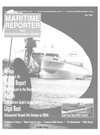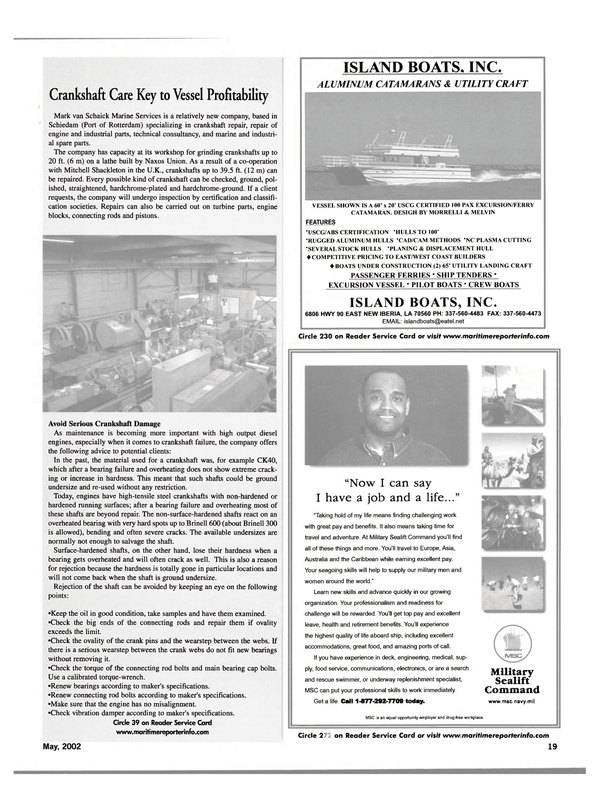
Crankshaft Care Key to Vessel Profitability
Mark van Schaick Marine Services is a relatively new company, based in Schiedam (Port of Rotterdam) specializing in crankshaft repair, repair of engine and industrial parts, technical consultancy, and marine and industrial spare parts.
The company has capacity at its workshop for grinding crankshafts up to 20 ft. (6 m) on a lathe built by Naxos Union. As a result of a co-operation with Mitchell Shackleton in the U.K., crankshafts up to 39.5 ft. (12 m) can be repaired. Every possible kind of crankshaft can be checked, ground, polished, straightened, hardchrome-plated and hardchrome-ground. If a client requests, the company will undergo inspection by certification and classification societies. Repairs can also be carried out on turbine parts, engine blocks, connecting rods and pistons.
Avoid Serious Crankshaft Damage As maintenance is becoming more important with high output diesel engines, especially when it comes to crankshaft failure, the company offers the following advice to potential clients: In the past, the material used for a crankshaft was, for example CK40, which after a bearing failure and overheating does not show extreme cracking or increase in hardness. This meant that such shafts could be ground undersize and re-used without any restriction.
Today, engines have high-tensile steel crankshafts with non-hardened or hardened running surfaces; after a bearing failure and overheating most of these shafts are beyond repair. The non-surface-hardened shafts react on an overheated bearing with very hard spots up to Brinell 600 (about Brinell 300 is allowed), bending and often severe cracks. The available undersizes are normally not enough to salvage the shaft.
Surface-hardened shafts, on the other hand, lose their hardness when a bearing gets overheated and will often crack as well. This is also a reason for rejection because the hardness is totally gone in particular locations and will not come back when the shaft is ground undersize.
Rejection of the shaft can be avoided by keeping an eye on the following points: •Keep the oil in good condition, take samples and have them examined.
•Check the big ends of the connecting rods and repair them if ovality exceeds the limit.
•Check the ovality of the crank pins and the wearstep between the webs. If there is a serious wearstep between the crank webs do not fit new bearings without removing it.
•Check the torque of the connecting rod bolts and main bearing cap bolts.
Use a calibrated torque-wrench.
•Renew bearings according to maker's specifications.
•Renew connecting rod bolts according to maker's specifications.
•Make sure that the engine has no misalignment.
•Check vibration damper according to maker's specifications.
Circle 3 9 on Reader Service Card www.maritimereporterinfo.com
Read Crankshaft Care Key to Vessel Profitability in Pdf, Flash or Html5 edition of May 2002 Maritime Reporter
Other stories from May 2002 issue
Content
- Delta Queen Makes A Comeback page: 3
- USS Cole Returns to Fleet page: 4
- Polar Discovery Christened at Avondale page: 7
- Heidenreich Marine Reorganizes Companies page: 8
- Transas Breaks Through Visual Technology page: 8
- Navibulgar Finalizes Varna Shipyard Deal page: 9
- Horbeck-Leevac To Build Eight OSV's page: 9
- Navibulgar Initiates Fleet Renewal Program page: 9
- OSHA Standards Applicable on Uninspected Vessels page: 10
- Munson Delivers PACKCAT to U.S. Navy page: 11
- U.S. Navy Awards Northrop Grumman $ 1 . 3 B LHD Contract page: 11
- Shipboard Life in Style page: 12
- Has the Fast Cat Come to A Halt? page: 15
- Market Changes Mold RoRo Ship Conversions page: 16
- Seville Delivers RoPax Ferry page: 18
- Crankshaft Care Key to Vessel Profitability page: 19
- AIS:When & Where? Here & Now! page: 20
- Crowley Subsidiary Christens ATB page: 24
- Ballast Water Treatment Through Biodispersion page: 26
- LNG Breakthrough For Wartsila page: 29
- New Measures on Ballast Water Management Approval page: 32
- The GMD Group - A Young, Ambitious Team page: 33
- Seven Seas Mariner Undergoes Pod Adjustment page: 34
- Teekay Foam's Discharge Pipe Repaired in Bilbao page: 36
- Government Ships Spend Time At Cascade page: 38
- ASRY Continues Brisk Repair Pace page: 39
- FRP Pumps Offer Lasting Results page: 40
- Spray-On Insulation Cuts Maintenance Costs page: 42
- SEI Temp-Set Reusable Insulation Covers page: 42
- EU to Develop Sulfur Strategy page: 43
- CITGO Offers "No Sheen" Aquamarine Oils page: 43
- Good Fuel = Good Profits page: 44
- Lubes Keep Step With Diesel Development page: 44
- Jeamar's Winches Are Made To Order page: 45
- Victoria Shipyard Racks Up Cruise Ship Jobs page: 45
- Targeting Greek Shipping's $16B Budget page: 46
- Elefsis Helps Speed LNG Retrofit page: 47
- Stelmar Set To Expand Fleet, Receives Tanker page: 51
- HHI: To Infinity & Beyond page: 52
- Dual-Fuel Finds A New Backer page: 57
- U.S. Navy Selects Gold Team For DD(X) page: 57
- Packing Solutions Help Bear Set Sail page: 57


